Wondering how to grow thick mung bean sprouts at home? Here is a detailed, step-by-step guide and recipe for you to grow bean sprouts at home. It is super easy and involves mainly two parts - soaking and providing them with the right environment to grow healthy.
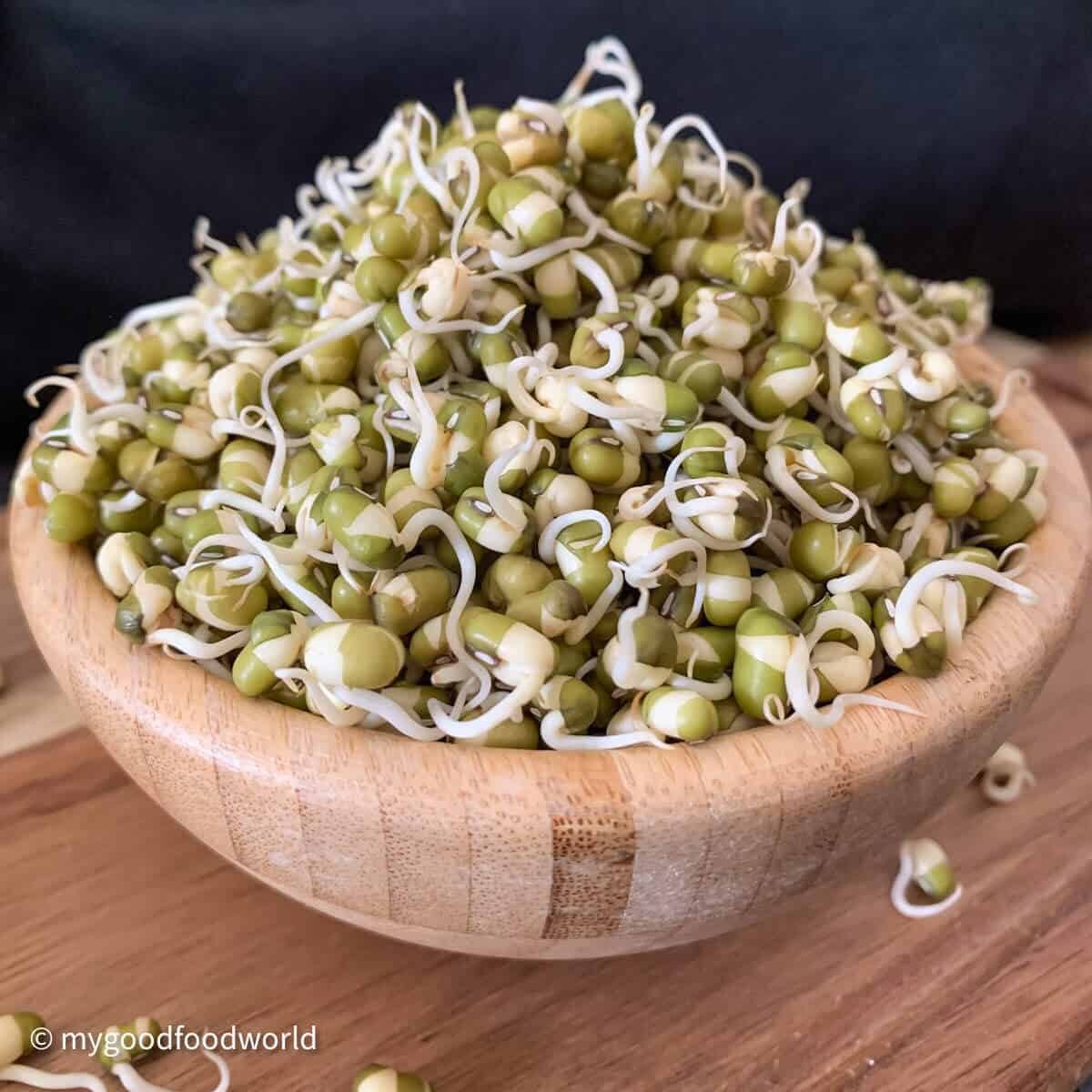
Of all the legumes, mung beans (moong beans, green gram, or green moong dal as they are also known) are my favorite. An Indian household is incomplete without a good stock of these!
As a dependable fall-back, I always have a box of green mung beans - boiled or sprouted - in my fridge.
Once they are prepped i.e. soaked and boiled or soaked and sprouted, it is a breeze to turn them into a delicious dish - this green moong dal and mung bean salad, for example.
Pesarattu, a savory crepe made with soaked green gram, is one of the favorite holiday breakfast recipes in the Kumars household!
What is your favorite legume or bean? Do let me know in the comments below. I would love to hear from you - Padma.
Jump to:
What you need to grow mung bean sprouts
There are two ways in which you can sprout the beans.
In a thin cloth towel or a muslin cloth OR
In a colander over a small bowl and cover with a moist cloth.
For the cloth method:
- A large bowl (to soak the beans in)
- A large cloth towel or muslin cloth (to make a bundle)
For the colander method:
- A colander
- Small bowl (to place the colander on)
- Thin cloth (to cover the colander)
1 glass jar or box with a lid (for storing the sprouts)
Mung beans and water, of course!
Note: 1) You can grow mung sprouts in a mason jar or a tray and 2) If you do not have a towel or muslin cloth, use paper towels instead.
How to grow thick mung bean sprouts: a step-by-step guide
Growing thick mung bean sprouts at home without soil is actually very simple. Once you have the right supplies and a good understanding of the process, you can enjoy your own supply of nutritious sprouts with minimal effort.
1. Wash and Soak
Place ½ cup dried mung beans in a large bowl and wash them 1-2 times.
Drain and keep them aside.
The beans that are not of good quality will float up in the water. They will not sprout properly. Discard them.
Place the beans back in the large bowl.
Pour 3-4 cups of clean water and soak them overnight (8-9 hours).
The beans will double in size and so plan your bowl size accordingly.
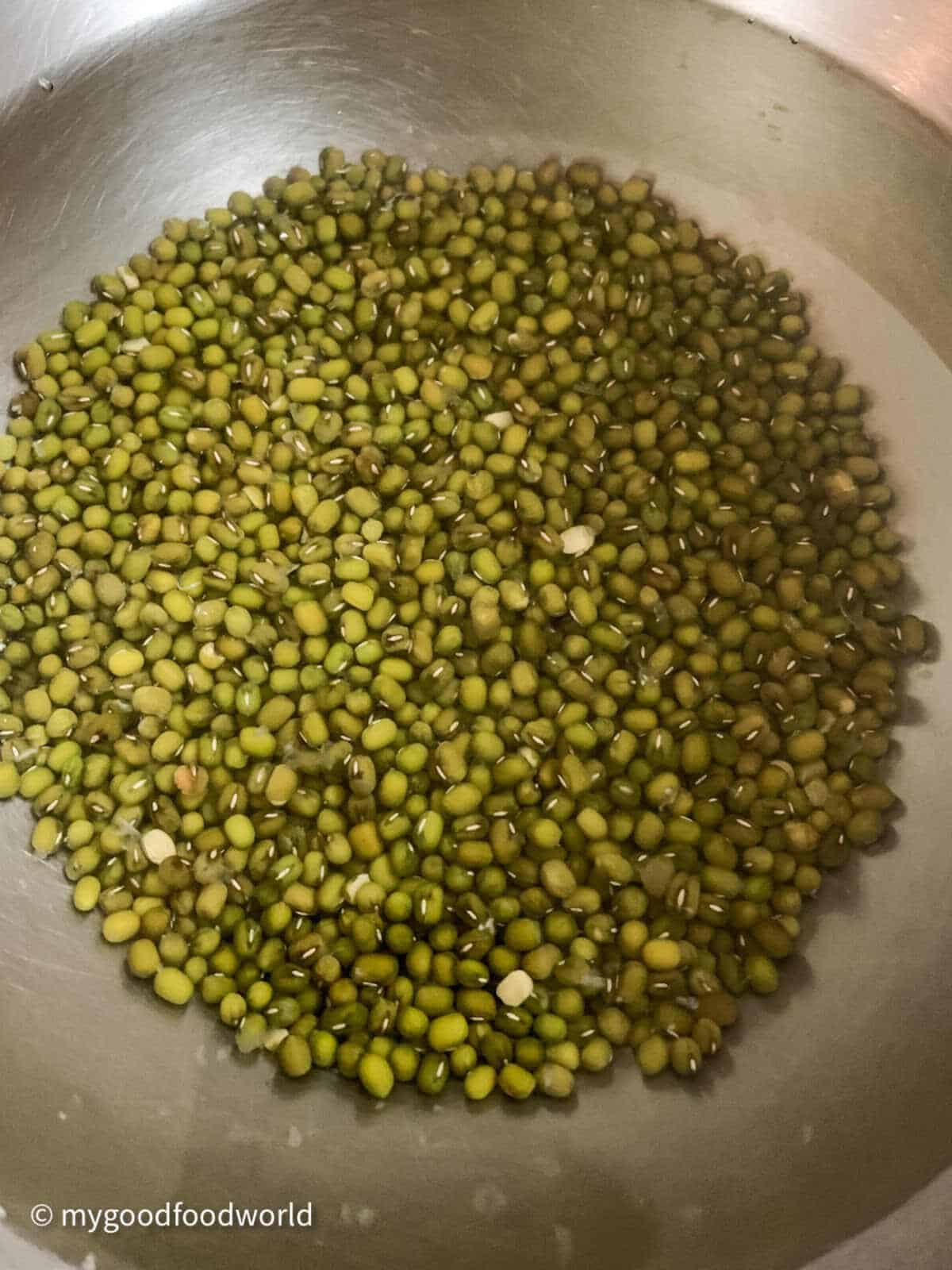
2. Prepare the environment
The next morning, discard the water in which the beans were soaking and wash them a couple of times.
Use gentle hands. At this stage, the beans are delicate and will break if handled roughly.
You will notice that the mung beans have cracked, showing the white part of the legume. This is a sign that they are ready to sprout.
Pick out any beans that have not sprouted and discard them.
Cloth method: Moisten the cloth and place it in the large bowl (the ends should hang out of the bowl comfortably) and place the mung beans on it.
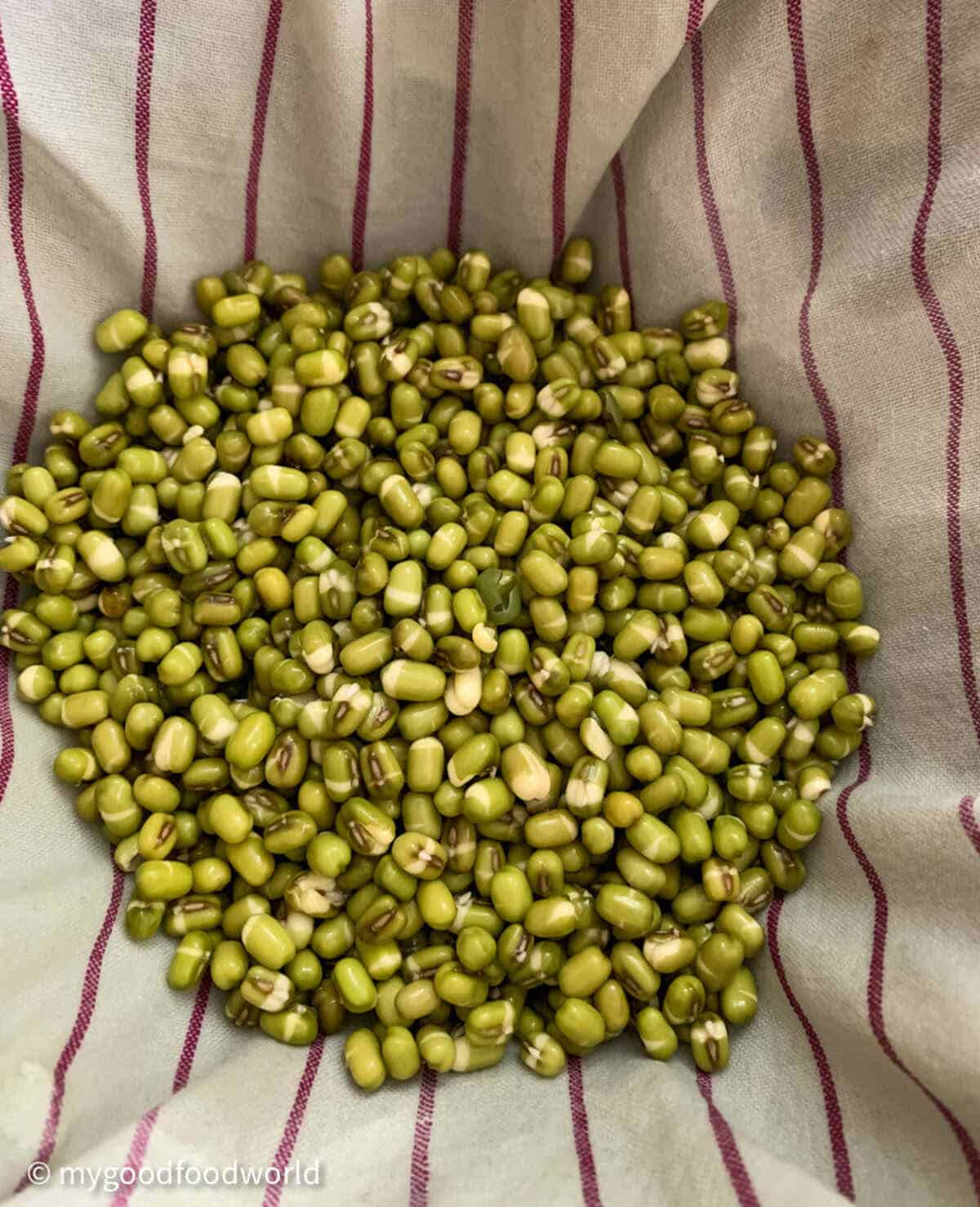
Wrap the towel/cloth in a snug bundle and place it back in the bowl.
Place the bowl in a well-ventilated, dark, and dry place, away from direct sunlight and in the warmest spot in your kitchen. Let them be for 24 hours.
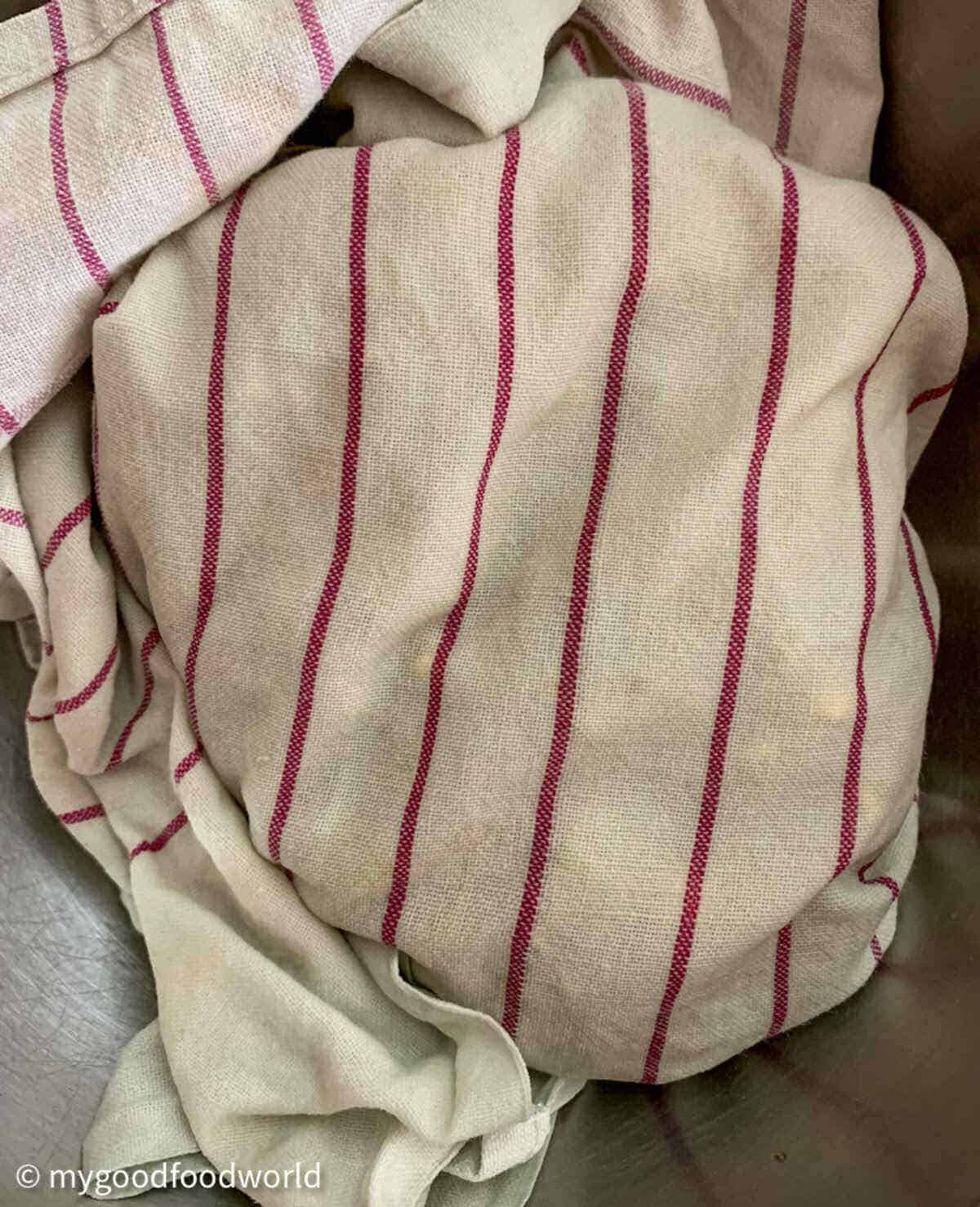
Colander method: Place the mung beans in a colander and place the colander over a bowl. Cover with a thin, moist cloth.
Place the colander in a well-ventilated, dark, and dry place, away from direct sunlight, and in the warmest spot in your kitchen.
Let them be for 24 hours.
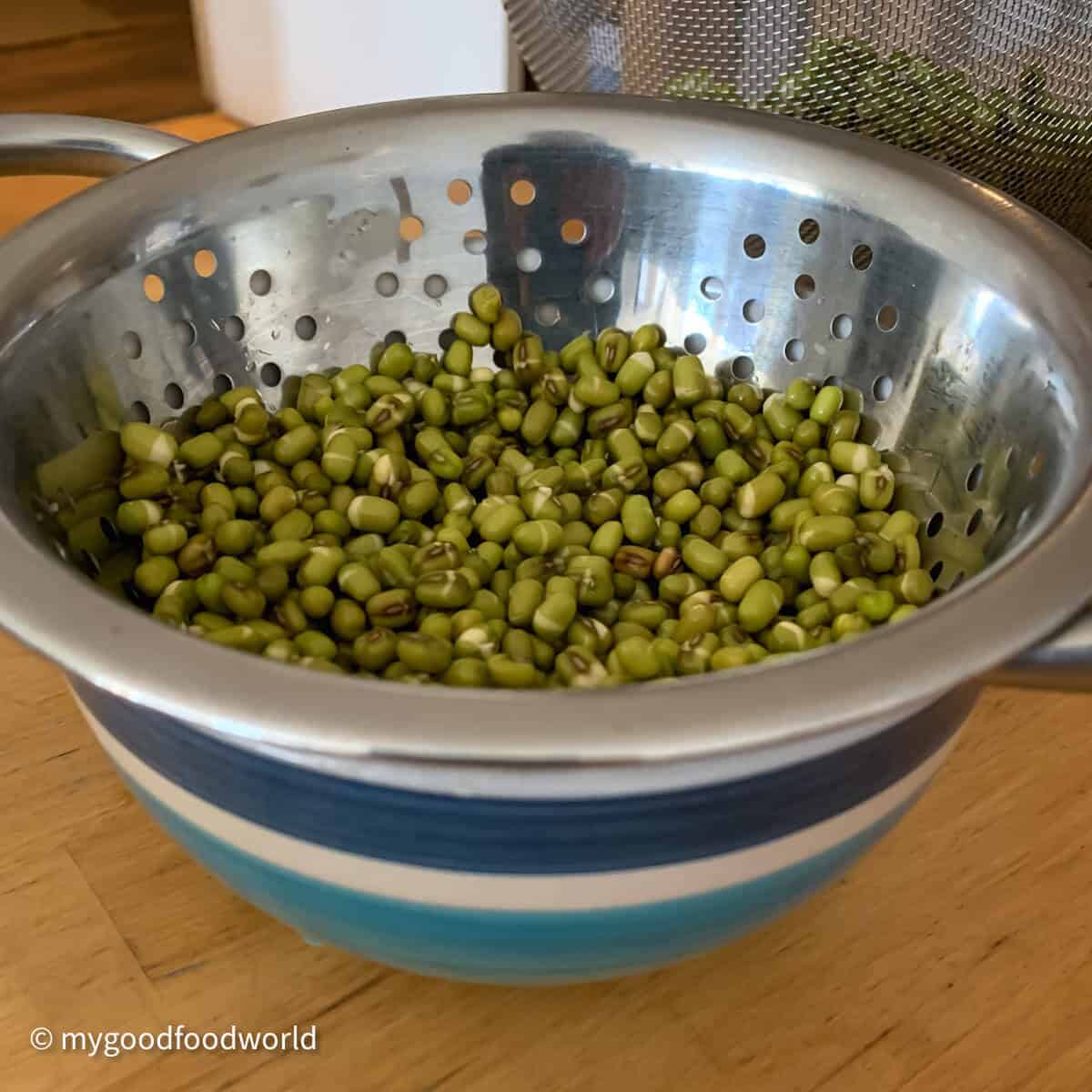
3. Sprouting
Day 1: After 24 hours, (you will see that the beans have tiny sprouts) gently tip them from the cloth into a bowl, rinse gently, and drain them.
Place them back in the cloth, wrap them, and place the bundle in the bowl.
Let them be for another 24 hours.
If sprouting in a colander, rinse the mung beans directly in the colander (be gentle), drain the water completely, and place the colander back over the bowl. Cover with a moist cloth and keep it aside for another 24 hours.
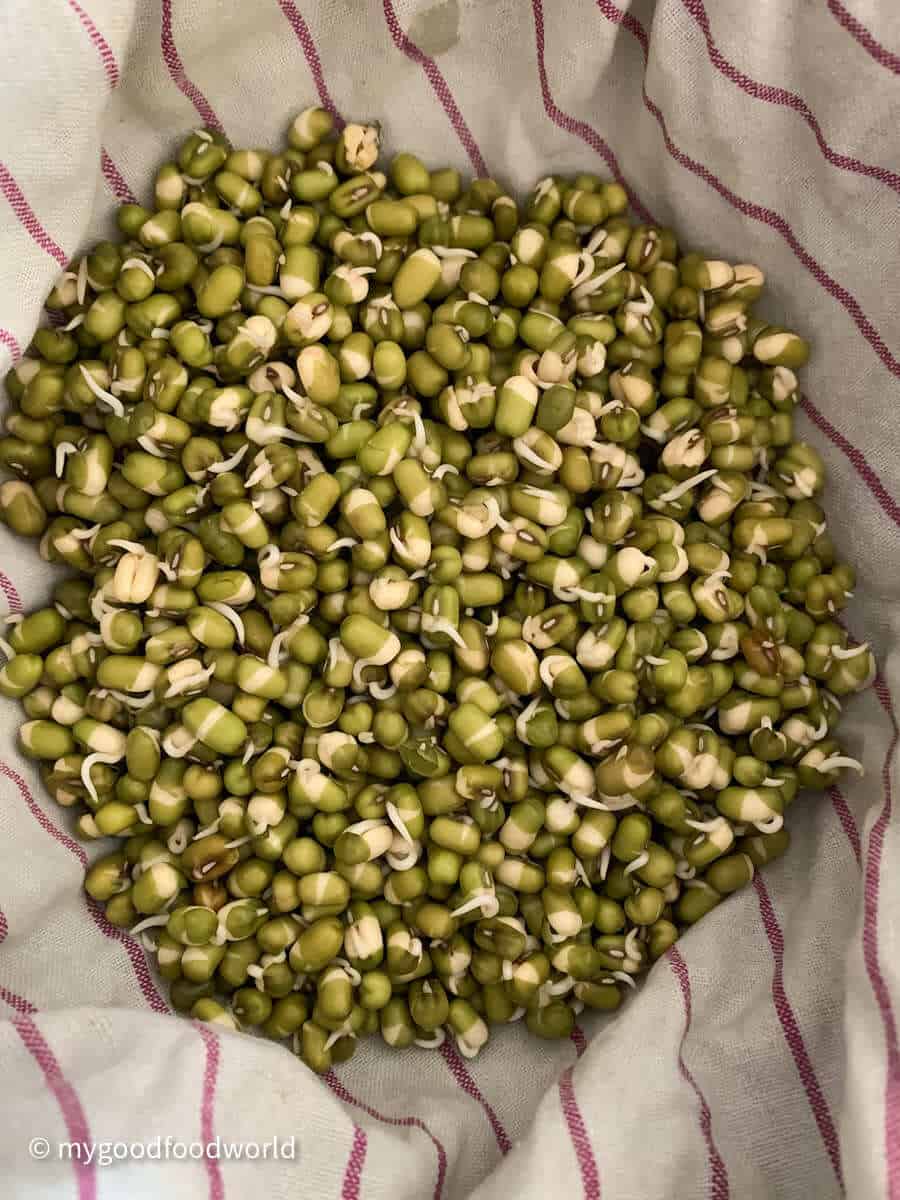
Day 2: The sprouts will get going and would have grown longer 🙂.
Rinse them in the same way as before and keep them aside for another 24 hours.
This time, place a heavy object (such as a skillet/saute pan) on the bundle (or in the case of a colander, on the moist cloth). This encourages the shoots to grow thick and straight.
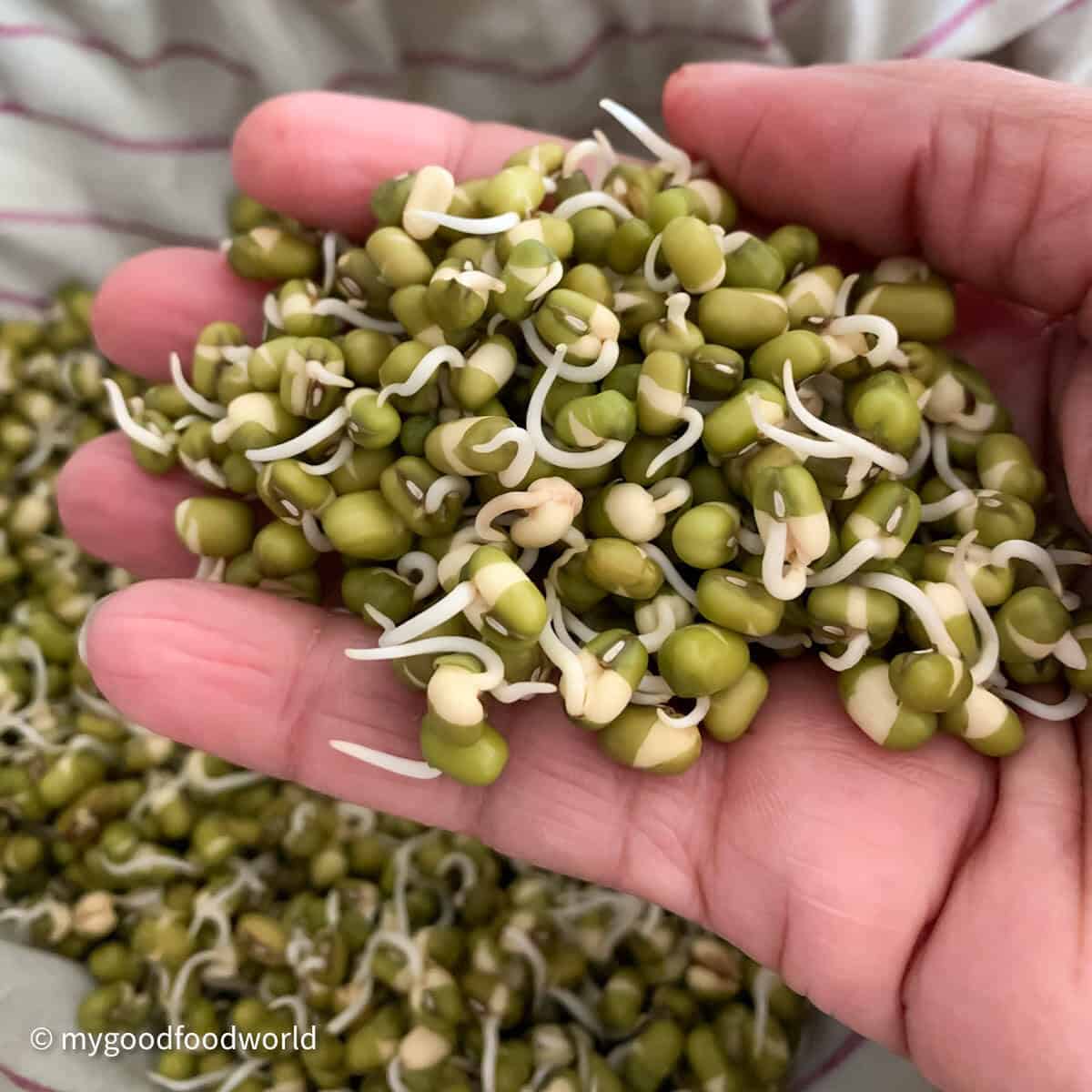
Repeat the above process till the sprouts have grown at least 2 centimeters in length.
Depending on where you live and the weather conditions, this will take 3 or 4 days.
Rinse the mung bean sprouts once again before using them.

Tips and notes
Keeping the beans moist: For the sprouts to be healthy and thick, it is important that they are moist. Sprinkle some water on the cloth/ paper towel to keep the sprouts moist.
Remember: Rinse the beans every 24 hours and sprinkle some water to keep them moist (if needed) every 12 hours or so.
Cover the mung beans - this is one of the ways to ensure thick and luscious sprouts.
Top tip: Place a heavy object such as a saute pan, on the bundle or cloth. This helps the sprouts to grow in one direction and therefore be thick and healthy.
Notes
Yield: 1: 2 ratio of dried to sprouts.
Typically dried mung beans will double in weight after sprouting. I have used here 2½ oz. (70 grams) of dried mung beans. When I weighed them after sprouting, they weighed, roughly, 5 oz. (150 grams).
Other ways to sprout mung beans:
- bamboo steamer or regular steamer basket instead of a colander.
- kitchen towels instead of cloth.
- tray
- glass jar - make sure that the mung beans are getting enough ventilation - keep the lid partially open.
How long should the sprouts grow? The ideal length is about 2 centimeters. You can grow them longer, but they will lose their natural sweetness.
Can you sprout beans for too long? Yes, if the sprouts are left to grow for too long, they may become slimy and unappetizing and may taste bitter.
Sprouting in cold weather: The mung beans require warmth to germinate and grow healthy shoots. If the weather is cold, you may need to help them along a bit by:
- soaking them in warm water.
- finding the warmest spot - in a cold oven, next to the fridge, or in your Instant Pot (yogurt mode).
Why is my bean sprout so skinny? In order to grow healthy, thick sprouts, make sure you have soaked your beans enough (8-9 hours) and then kept them in a warm, dark place to grow. Rinse the beans once every 24 hours and sprinkle them with water every 12 hours. Weighing them down also helps in growing thick, lush sprouts.
Caring for the beans:
- The sprouting beans will need a lot of space for the shoots to grow. Make sure that the container they will be sprouting in is large enough for that.
- Do not sprout the beans in a container that has a fine mesh (like a sieve) - the growing shoots will get stuck in the fine mesh and break.
- Keep them moist and not wet. Wet mung beans will become moldy and eventually rot.
- A warm and dark place helps to germinate the beans and grow healthy shoots.
- Keep them away from direct sunlight. Sunlight will cause the beans to be overly dry, resulting in poorer-quality sprouts.
Storing bean sprouts
- Remove the excess water and drain your sprouts well.
- Spread them in a thin layer on a towel and allow them to air dry completely (they will last longer).
- Line a fridge-safe container with paper towels and store the sprouts in the fridge.
How long will the mung sprouts last? Although the sprouted mung beans will last, in the fridge, for up to a week or 10 days, they will be at their peak freshness for about 2-3 days.
Freezing: You can freeze bean sprouts. However, they will not be crunchy and juicy when you thaw them.
What is sprouting?
Sprouting is the natural process by which the seeds germinate and begin to grow into shoots. The seeds are required to be soaked in water, drained, and rinsed at regular intervals. Sprouting enhances nutrition and taste.
Can I sprout anything? You can sprout most beans, seeds, and legumes with some exceptions such as alfalfa sprouts and red kidney bean sprouts. Mung beans are the easiest and fastest to sprout. Adzuki bean sprouts are also quite easy to make.
Read more about sprouting.
A note about moong beans
Mung beans (scientific name vigna radiata) have been cultivated in India and the Southeast Asian regions for thousands of years!
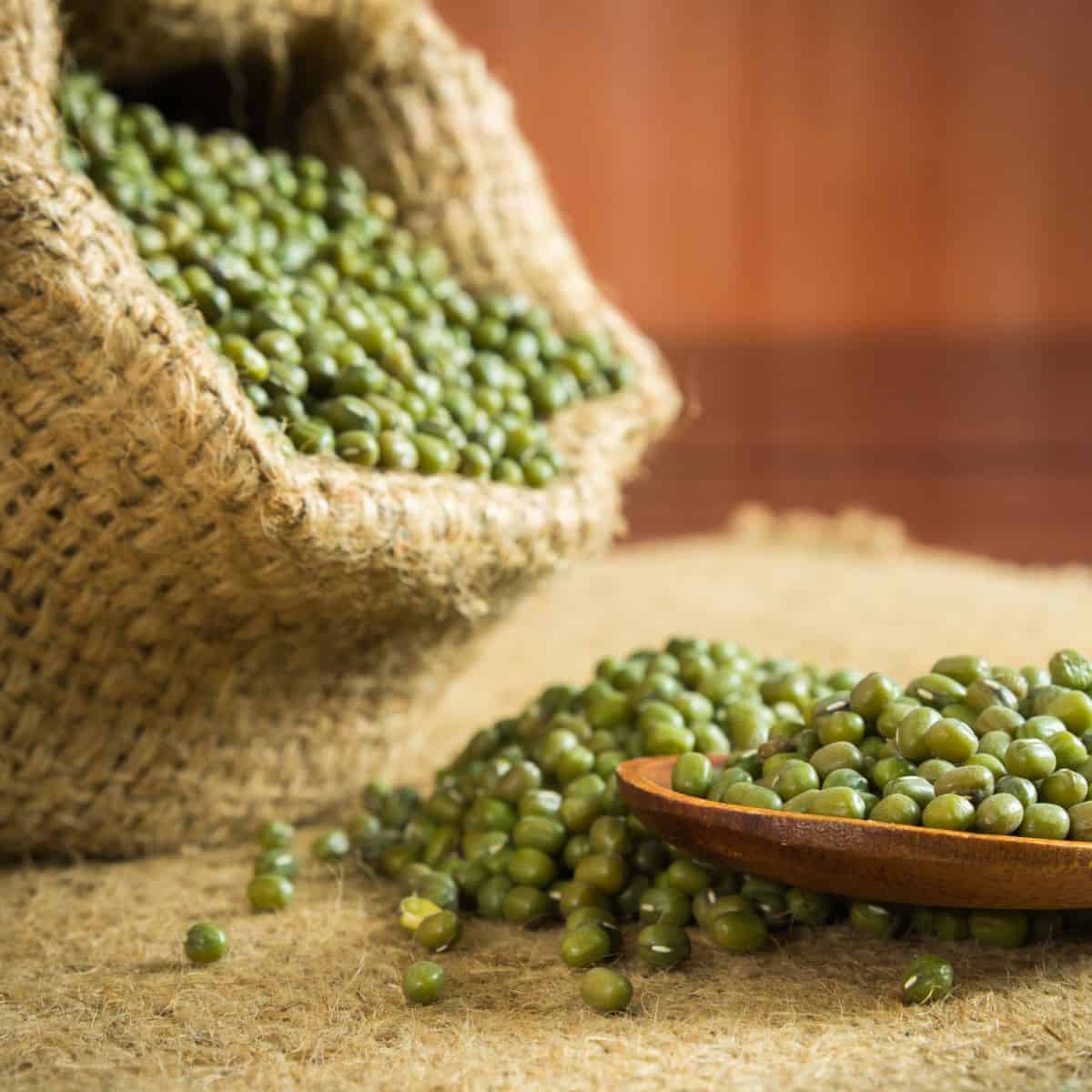
In Ayurveda, both mung beans and mung lentils (the skinned, split lentils of the mung bean) are greatly cherished.
Mung beans are full of micronutrients and are easier to digest compared to other beans and lentils.
Traditionally mung beans and lentils are cooked with gut-calming spices such as ginger, cumin, turmeric, and coriander.
This yellow lentil soup is my go-to favorite!
Soaking and sprouting the mung beans further enhance their digestibility and nutrition.
Benefits of eating mung bean sprouts
Mung bean sprouts are low in calories and are a rich source of plant-based protein. They are rich in nutrients and micronutrients such as iron, calcium, and vitamins C and K. They are also an excellent source of antioxidants.
You can eat raw bean sprouts or add them to your stir fry, soup, noodle, and rice dishes - the possibilities are endless!😍
Read more here about the benefits of eating mung bean sprouts.
FAQs
To get thicker mung bean sprouts, you need to give the beans adequate time to sprout. Start by soaking them overnight in water, then rinse and drain them once daily for up to four days until the desired thickness is achieved. Additionally, ensure that the beans are kept in a cool and dry place away from direct sunlight to maintain quality and flavor.
Rinse the beans every 24 hours and sprinkle some water to keep them moist (if needed) every 12 hours or so. Keeping the beans moist is important for the sprouts to be healthy and thick.
The moong beans should soak in clean water for 8-9 hours (overnight). Once harvested, i.e. removed the hulls and rinse the sprouts again, soak them in water for 5 minutes to make sure that they are hydrated and plump.
Mung beans germinate better in the dark as direct sunlight can cause them to become overly warm and dry, resulting in poorer-quality sprouts. Additionally, the color and taste of the sprouts may be affected if exposed to direct sunlight. For optimal results, keep your mung bean sprouts in the dark while they are sprouting.
I hope this post has helped you understand all the tips on how to grow thick mung bean sprouts. If you have found this useful, please take a moment to leave a comment and a rating below. You can also engage with me on Twitter, Facebook, and Instagram xxPadma
📖 Recipe

How to grow thick mung bean sprouts
Equipment
- 1 glass jar or box, (for storing the sprouts)
- 1 large bowl
- 1 clean, thin cloth towel or muslin cloth, (large) OR
- 1 colander
- 1 small bowl, (to place the colander on)
- 1 thin cloth, (to cover the colander)
Ingredients
- ½ cup green mung beans, (70 grams)
- 3-4 cups drinking water
Instructions
Wash and soak the beans
- Place the mung beans in a large bowl and rinse them 1-2 times. Drain and keep them aside.The beans that are not of good quality will float up in the water. They will not sprout properly. Discard them.½ cup green mung beans
- Place the beans back in the large bowl, pour the water, and soak them overnight (8-9 hours). The beans will double in size and so plan your bowl size accordingly.3-4 cups drinking water
Prepare the environment
- The next morning, discard the water in which the beans were soaking and wash them a couple of times. Use gentle hands. At this stage, the beans are delicate and will break if handled roughly. You will notice that the mung beans have cracked, showing the white part of the legume. This is a sign that they are ready to sprout. Pick out any beans that have not sprouted and discard them.
- There are two ways in which you can sprout the beans.1) In a thin cloth towel or a muslin cloth2) In a colander over a small bowl and cover with a moist cloth.
- Cloth method: Moisten the cloth and place it in the large bowl (the ends should hang out of the bowl comfortably) and place the mung beans on it. Wrap the towel/cloth in a snug bundle and place it back in the bowl. Place the bowl in a well-ventilated, dark, and dry place, away from direct sunlight and in the warmest spot in your kitchen. Let them be for 24 hours.
- Colander method: Place the mung beans in a colander and place the colander over a bowl. Cover with a thin, moist cloth.Place the colander in a well-ventilated, dark, and dry place, away from direct sunlight, and in the warmest spot in your kitchen. Let them be for 24 hours.
Sprouting
- Day 1: After 24 hours, (you will see that the beans have tiny sprouts) gently tip them from the cloth into a bowl, rinse gently, and drain them. Place them back in the cloth, wrap them, and place the bundle in the bowl. Let them be for another 24 hours. If sprouting in a colander, rinse the mung beans directly in the colander (be gentle), drain the water completely, and place the colander back over the bowl. Cover with a moist cloth and keep it aside for another 24 hours.
- Day 2: The sprouts will get going and would have grown longer 🙂. Rinse them in the same way as before and keep them aside for another 24 hours. This time, place a heavy object (such as a skillet/saute pan) on the bundle (or in the case of a colander, on the moist cloth). This encourages the shoots to grow thick and straight.
- Repeat the above process till the sprouts have grown at least 2 centimeters in length. Depending on where you live and the weather conditions, this will take 3 or 4 days.
- Rinse the mung bean sprouts once again before using them.
- If storing them for later, drain the water completely and let them dry a bit. Line a glass container or jar with paper towels. Close the lid and store them in the fridge.
Notes
-
- bamboo steamer or regular steamer basket instead of a colander.
-
- kitchen towels instead of cloth.
-
- tray
-
- glass jar - make sure that the mung beans are getting enough ventilation - keep the lid partially open.
- The sprouting beans will need a lot of space for the shoots to grow. Make sure that the container they will be sprouting in is large enough for that.
- Do not sprout the beans in a container that has a fine mesh (like a sieve) - the growing shoots will get stuck in the fine mesh and break.
- Keep them moist and not wet. Wet mung beans will become moldy and eventually rot.
- A warm and dark place helps to germinate the beans and grow healthy shoots.
- Keep them away from direct sunlight. Sunlight will cause the beans to be overly dry, resulting in poorer-quality sprouts.
- soaking them in warm water.
- finding the warmest spot - in a cold oven, next to the fridge, or in your Instant Pot (yogurt mode).
Alternative quantities provided in the recipe card are for 1x only.
Allergens Disclaimer
Our content aims to be informative and educational, but it should not replace professional medical advice. Since manufacturing processes can vary and cross-contamination is possible, it's essential to verify product labels and allergen information. Make sure all ingredients align with your specific allergies. As readers, you bear the responsibility for ensuring allergen safety when buying or consuming foods.
Disclosure: The nutritional information is calculated using an online calculator and is based on available ingredients and preparation. It should not be considered a substitute for a professional nutritionists' advice. Changing the quantities and cooking technique will alter the nutritional calculations.
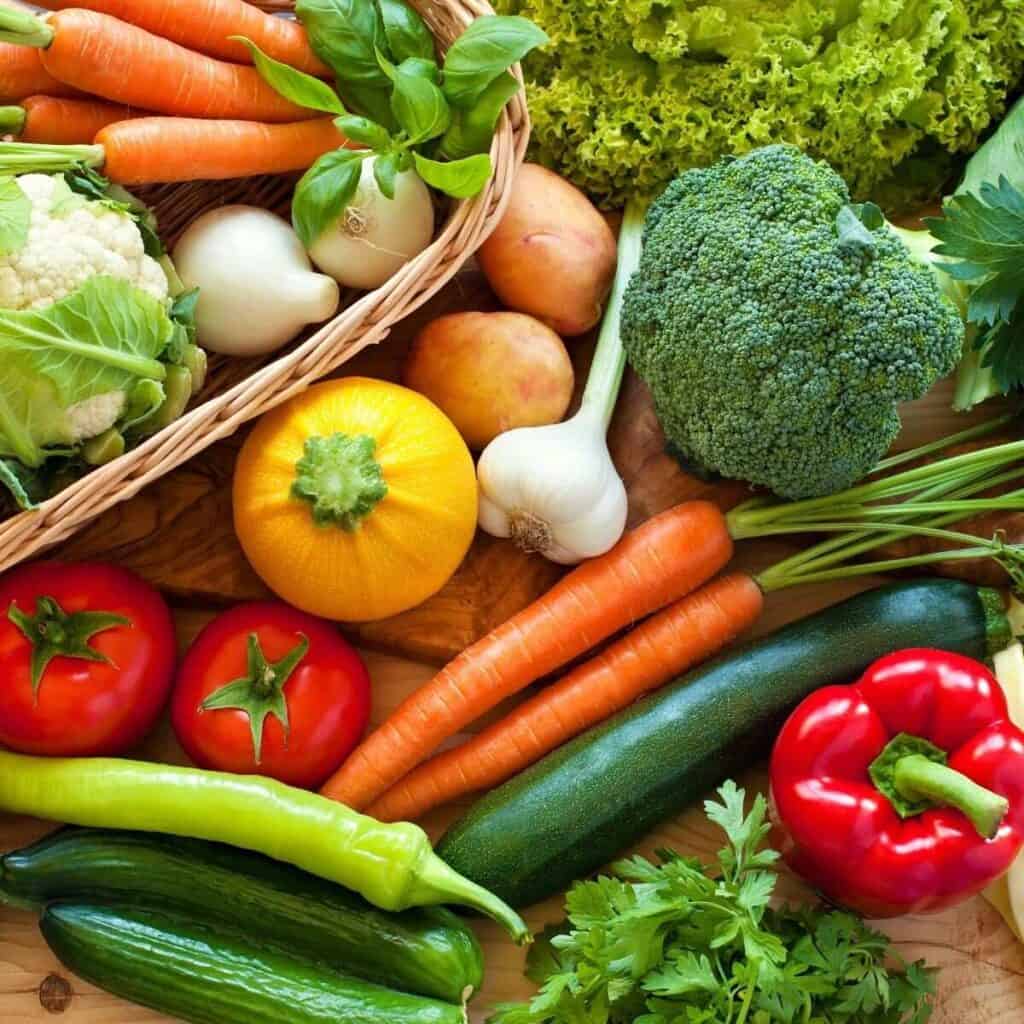
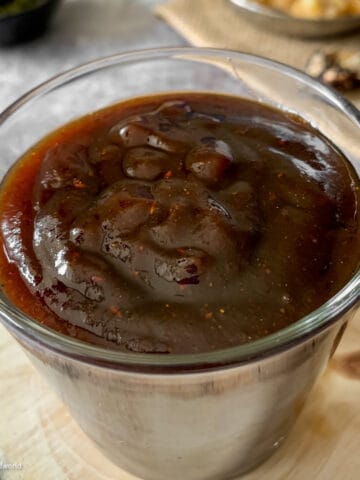
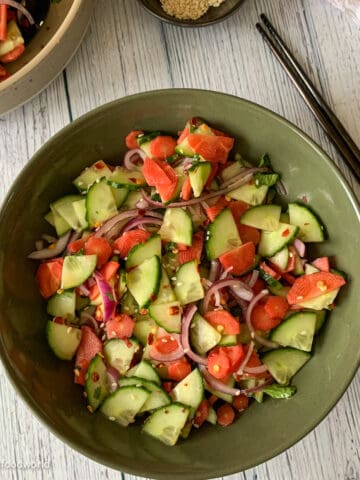
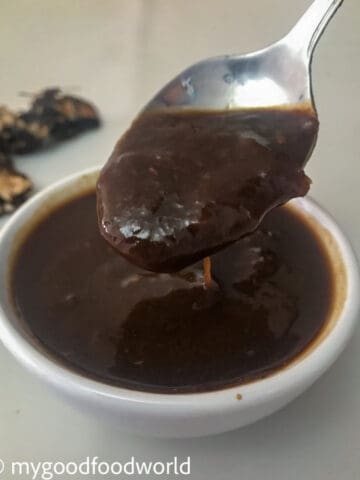

Sonja says
Thank you for all the information! Maybe this time I'll succeed!
Padma Kumar says
I hope it works out for you Sonja.
Alexandra says
Wow, thank you so much for this detailed and informative post. I have never tried to grow my own mung bean sprouts before, but I will be giving it a try in the new year. (It will be Summer here, so the warmer weather should help encourage them too.) Thanks again!
Nora says
So informative! Love your post! Never thought of growing them!
Jacqueline Debono says
My mung bean sprouts are growing and I'm really happy! Can't wait to use them!
Gloria says
Thanks for the great info. I have always wanted to try this. I think doing it at home is much healthier than buying these in the grocery store.
Andréa says
I never thought of growing mung beans myself. But with these great tips, I should be able to, I'm sure. Thank you for the inspiration.
Erin says
Love this idea of how to grow thick mung bean sprouts! I didn't know this could be done, but it worked so well. Thank you for sharing all of the great tips.
Padma Kumar says
So glad that you found it useful Erin.
Fransic verso says
Very cool and informative! I've never done something like this before but seems easy to do it. Thank you for sharing it!
Padma Kumar says
It is indeed very easy! Hope you can try it soon.